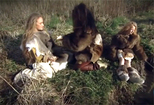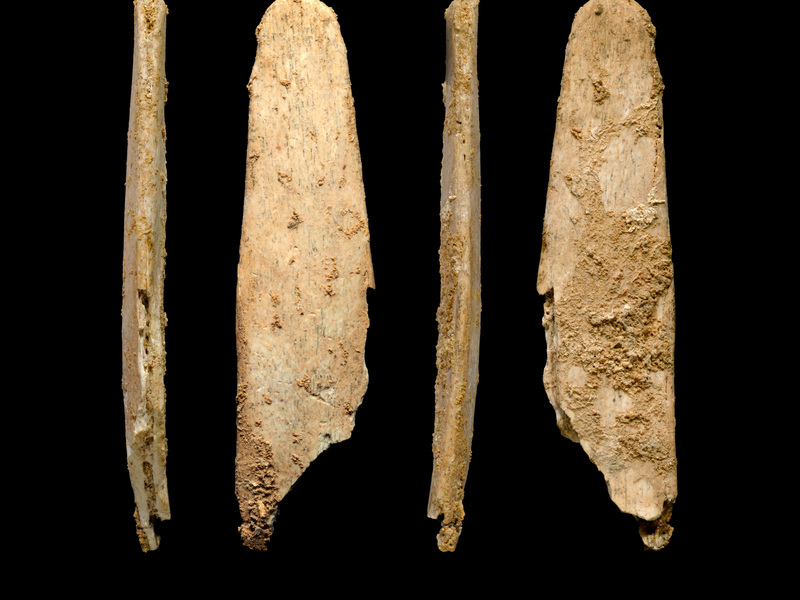
Four angles on the same preserved lissoir. Photo: Abri Peyrony & Pech-de-l’Azé I Projects
August 13, 2013 2:16 pm - Forget the stereotypes of Neanderthals as thick-headed dunces. Evidence is dripping out of archaeological digs across Europe that Neanderthals may have cooked, painted and, according to new research, made specialized bone tools. From a research site in France, scientists dug up bones which they say were used as a lissoir, a tool used for working hide into leather. And, based on the dated age of the research site, the bone tools were likely crafted by Neanderthals, not humans. Researchers reached that conclusion after analyzing four bone fragments from two separate Neanderthal sites in southwestern France. They confirmed that the artifacts showed clear evidence of being fashioned and utilized for a specific task — in this case, treating animal hides.
… The Neanderthal lissoirs are a significant find because they could force archeologists to rewrite the chronology of Paleolithic European humans. According to the researchers associated with the find, the lissoirs suggest either that modern humans arrived in Europe much earlier than believed, imparting their knowledge of tool-making to the resident Neanderthals, or that Neanderthals invented specialized tool-making independently of H. sapiens. A third theory suggested by the team, if proven, could be even more surprising given the long-standing stereotype of our low-browed relatives: perhaps it was the Neanderthal tool-maker who imparted his knowledge to modern humans.
Neanderthals had used bone before these lissoirs, but these more specialized tools shown a jump in technique. “McPherron cautioned that the researchers are not suggesting that Neanderthals were the first to make bone tools,” says Charles Choi for LiveScience. “There are sophisticated bone tools that are even older in Africa, for instance,” McPherron said. “Neanderthals were, however, the first in Europe to make specialized bone tools.”
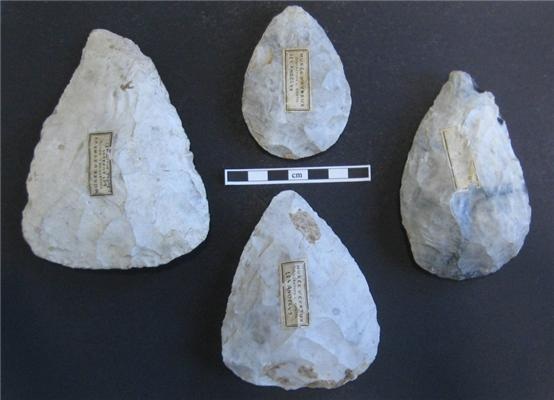
Neanderthal handaxes.
Aug. 19, 2013 — A study by a postgraduate researcher at the University of Southampton has found that Neanderthals were more culturally complex than previously acknowledged. Two cultural traditions existed among Neanderthals living in what is now northern Europe between 115,000 to 35,000 years ago. Dr Karen Ruebens from the Centre for the Archaeology of Human Origins (CAHO) and funded by the Arts and Humanities Research Council (AHRC) examined the design of 1,300 stone tools originating from 80 Neanderthal sites in five European countries; France, Germany, Belgium, Britain and the Netherlands. Dr Ruebens' investigations uncovered new evidence that two separate handaxe traditions or designs existed -- one in a region now spanning south-western France and Britain -- the other in Germany and further to the East. In addition, she found an area covering modern day Belgium and the Netherlands that demonstrates a transition between the two. She comments: "In Germany and France there appears to be two separate handaxe traditions, with clear boundaries, indicating completely separate, independent developments. "The transition zone in Belgium and Northern France indicates contact between the different groups of Neanderthals, which is generally difficult to identify but has been much talked about, especially in relation to later contacts with groups of modern humans. This area can be seen as a melting pot of ideas where mobile groups of Neanderthals, both from the eastern and western tradition, would pass by -- influencing each other's designs and leaving behind a more varied record of bifacial tools." The University of Southampton research has revealed Neanderthals in the western region made symmetrical, triangular and heart-shaped handaxes, while during the same time period, in the eastern region, they produced asymmetrically shaped bifacial knives. Dr Ruebens says: "Distinct ways of making a handaxe were passed on from generation to generation and for long enough to become visible in the archaeological record. This indicates a strong mechanism of social learning within these two groups and says something about the stability and connectivity of the Neanderthal populations. "Making stone tools was not merely an opportunistic task. A lot of time, effort and tradition were invested and these tools carry a certain amount of socio-cultural information, which does not contribute directly to their function." The study's extensive analysis also shows other factors which could have influenced handaxe design, such as raw material availability to Neanderthals, the function of their sites, or the repeated reuse and sharpening of tools -- didn't have an impact in this instance. ( http://www.sciencedaily.com/releases/2013/08/130819090128.htm
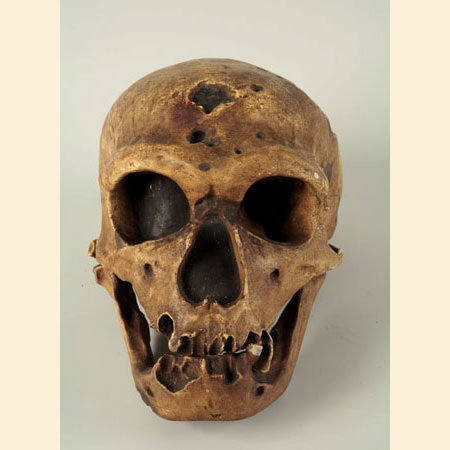 Cranium of an old Neanderthal male from La Chapelle-aux-Saints. Plaster cast. Definite Neanderthal traits * Eyes deeply set. Reference: “Close-set small eyes are deeply sunk under the “visor” of the heavy brow ridges” . * Prominent premaxilla. Reference “Morphologic study of the premaxillary suture at its different borders (i.e. the nasal aspect of the frontal process, nasal and palatal aspects of the palatal process of the maxilla) indicates a persistence of the suture among very young Neandertal children in comparison to the condition in extant ones.” * Palate high/narrow. Reference “The palate is narrow and extremely high.” * Macrodontia/teeth asymmetry/abnormally shaped teeth. Reference “Taurodontism is a condition found in molar teeth where the body of the tooth and pulp chamber is enlarged vertically at the expense of the roots.” “The condition is of anthropological importance as it was seen in Neanderthals.” * Large nose. Reference “The Neanderthal’s huge nose is a fluke of evolution, not some grand adaptation, research suggests.” * Nose bridge prominent. Reference “And heavy supraorbital ridges met across the bridge of the nose.” * Nose concave. Reference “A concave, angled nasal profile.” * Lower jaw prominent. Reference “The concept of forceful chewing is also evidenced by the heavy jaw.” * Toes widely spaced. Reference “a gap of 1.6 cm marks the separation of big and second toes.” Inconclusive * Brachycephaly. Reference “I believe strongly in neanderthal origins of europeans. Another fact is that we find brachycephal neanderthals exactly where today live dinaric people (Brachycephal); the only brachycephalic neanderthals are those of Crapina and Vindija caves in Croatia. Others were dolichocephalic, as are the people of the same places today.” Traits that cannot be assessed * Face coarse * Forehead prominent Neanderthal had prominent brow ridges and a low sloping forehead. It is not straight-forward if this means they had prominent forehead or not. * Macrostomia * Microstomia * Short philtrum * Upper lip cupid bow * Long uvula * Ear low-set * Ear posteriorly rotated * Ear lobe crease * Toes syndactyly * Hypermobile/hyperlax joints * Multiple nevi * Hypo-/depigmentation patches * Open mouth appearance * Abnormal whorl (non-frontal) * Full cheeks * Periorbital fullness * Eyebrows arched * Lower lip full * Upper lip thin * Prominent philtrum * Dimpled/grooved chin * Prominent ear * Ear lobes attached * Inverted nipples * Dry skin * Nails striped * Toe proportions Unintersting traits * Face asymmetry * Eyes asymmetry * Mounth asymmetry * Halluces valgus * Face expression less/dull * Clinodactyly * Pes Planus (flat feet) Conclusion Nine of the traits had a definite Neanderthal connection, one was questionable, and 29 could not be assessed due to them not being related to bone structure. None of the traits could be ruled out as definitely not of Neanderthal origin. An additional seven traits are probably related to problems with hybridization (mostly asymmetry). List and words by Leif Ekblad
Svante Paabo – Director, Department of Genetics, Max Planck Institute for Evolutionary
Anth ropology, Leipzig, Germany
African people does NOT have Neanderthal DNA at all. Please delight yourself with this: Neanderthal Bone Flute Music – YouTube Oldest musical instrument in the world ( Short film, full title is Playing the Neanderthal flute of Divje babe, is authored by Sašo Niskač, music is performed by Ljuben Dimkaroski, scientific adviser is Dr. Ivan Turk, archaeologist.) Neanderthals left Africa (suposedly) some 500,000 years ago. And they went up in the East and went to Europe. What I think is that they already quite evolved to the European rough environment; “Peter Parham, professor of microbiology and immunology at Stanford, recently presented evidence to the Royal Society in London that Europeans gained many of the genes for human leukocyte antigens (HLAs) from neanderthals. And PERSONALLY since they have a common ancestor, were the Neanderthal really the “previous” of the Sapiens, or really a different specie? When the africans came again, but as Sapiens they mixed with Neanderthals this happened: “Interbreeding between humans and Neanderthals may have given Europeans and Asians resistance to northern diseases that their African ancestors didn’t have.”. Otherwise they wouldn’t had resisted and overcomed the Ice Age European conditions. What really makes me wonder… is that, everywhere, homo sapiens are claimed to be “totally innovative, creative, and intelligent”. And what made that all non 100% Homo Sapiens evolved to the extreme of complete civilizations and modern world? Even Egypt.. “George Gliddon in his book Ancient Egypt: Her monuments, hieroglyphics, history and archaeology (1844) wrote: “The Egyptians were white men” “The Italian anthropologist Giuseppe Sergi (1901) believed that ancient Egyptians were the African (Hamitic) branch of the Mediterranean race, which he called “Eurafrican”" Because only the 100% african persons have 100% Sapiens gens.
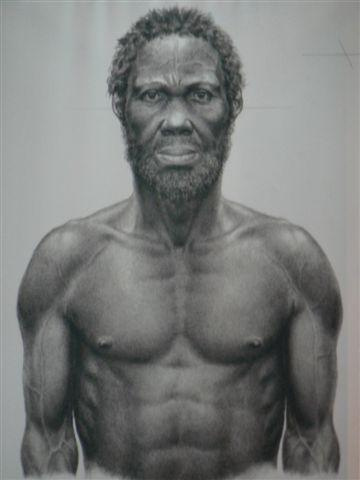
Original Homo Sapiens
If they were SO advanced and “marvelous”, and “innovative”, and “great”.. why is the non-northern Africa part (the one 100% african(Sapiens) the most un-advanced place in the world? Even Asians share some of the Neanderthal gens. Because there were two waves of Africans. I mentioned the first, and the second one, they pulled the little Neanderthal gens (out of Europe)further into Asia, and even the Americas. Here a map with it, from a german documentary, only available in spanish and german in youtube: Documental Lo Que Queda De Neandertal En Nosotros – YouTube (Here the German entire documentary by parts, in german, for those who know German: https://www.youtube.com/watch?v=rtIz4gTDfkw ) (And there is still some nonsense, and few "details"... like showing the african Sapiens as totally white persons) One thing can’t be negated, Neanderthal is the true original ancestor of all Europeans. They buried their dead (and sapiens did NOT) . They even performed rituals, and protected the buried corpse of beasts that could come to eat them. There is also evidence that babies and infants were buried in shallow pits, and others in natural fissures as well as shallow excavated graves. That was never practiced by the sapiens… not even just the burial. In addition, in Germany, between the scientists, it’s well assumed the use of language among them, and this even appears in this video. They also worked with different kinds of colors for something like makeup, and there are articles on the internet that show how they had special penchant for dark colors and black in these pigments, as if it meant something special for them. They also had special utensils, that speculated they had some kind of ancestral religion. A study led by the Gibraltar Museum and published in PLOS ONE documented a multitude of fossil remains of bird wings, particularly from big black raptors, at Neanderthal sites in southern Europe. The team suggested that Neanderthals could have been plucking feathers from the wings for personal use or for ritual ornaments. Also appears in this video, that they hunted in groups, and that they had social strategies as in this quote “Neanderthals apparently lived in small nuclear families. Clearly There is evidence for some amount of social networking, treats including Between family interaction or Neighboring groups. “. Also in this video comes off as they alone, had this spirit and value of care for one another, and valued everyone as part of a group that was sustained by merit of each of the members. And when someone got hurted, they cured them and seem to have practised medicine!(by knowing about herbs and plants). Among very many other things that are discovered every year.. In addition as I already mentioned (part of this), they were a lot stronger and more muscular than the sapiens, and above all, without interbreeding with Neanderthals, they would not have been able to support many of the viruses that had the ice age in Europe , and they would have been able to tolerate the cold. “Neanderthals have gone from being different from us to being like us”
“They’re looking like [Homo sapiens] hunter-gatherers look”
“ From the first Neanderthal remains were found in the 19th century the first to investigate these findings was of course the church. The idea that a European «savage Pagan» was more intelligent than modern man or indeed the creators of the Christian faith was just too much to them.Because of that the Neanderthals, the original European native, was presented in a very unflattering light. He became a semi-animal, a brute half-monkey, a revolting, filthy and primitive sub-human. They even concluded that he probably didn’t even have the ability to speak. It was just another beast of nature.Some European scientists tried to present the Neanderthal in a more accurate light, but they stood no chance against the church, their power and their propaganda machinery. The Neanderthal thus to this day is thought of as a sub-human.” ( The Sub-Human Neanderthal | Thulean Perspective) Here more about the flute**: ” One of the notable finds at Divje Babe in 1995 is the putative 50,000 year-old flute, known as the Neanderthal Flute. It is a juvenile cave bear femur, broken at both ends, but showing 4 holes in line.Found in 1995 by Ivan Turk in Slovenia, at the Divje Babe site, the juvenile cave bear femur bone, known as the Divje Babe flute, was a major find of recent times. The reason for that was because it provided significant evidence that Neanderthals may have been the equal of Homo Sapiens in the evolution of humankind. It became the oldest known musical instrument, and the first known instance of a diatonic musical scale sequence.” http://www.greenwych.ca/divje-b.htm
“Let’s see who can can explain me this. When it’s said that two individuals belong to the same species, it’s in the case that they can reproduce and create fertile offspring, right? Now, if Neanderthals and sapiens could reproduce, and their descendants, then they belonged to the same species, right?.”
“Can a dog breed with a wolf? The answer is yes and in fact this hybrid can be reproduced with another dog without problems, because, its genome is similar between the two species, in the case of humans, the Neanderthals and sapiens had a common ancestor, Homo antecessor (currently science considers it a variety of Erectus until further confirmation).
In cultural terms, the Neanderthals buried their dead, primitive sapiens, did not.
The term “species” is subjective and therefore subject to personal interpretation, and humans has not been able to discern whether Neanderthals and sapiens were different species or different races of the same species.
The theory of the Neanderthals disappearing because of sapiens is not well sourced, even less when a genetic study of the world’s population now determined that the human race descended from a group of a few thousand humans 27,000 years ago. “
And, how funny is how they mounted an evolutionary history out of 16 individual bones.. “How could a hominid, considered clumsy and unintelligent know how to hunt in group, with spears and arrows, know fishing, know tanning the hides of the animals he hunted to use as shelter, make tools of bones, wood and stones, pipes and drums, and bury their dead?
It is also said that they could not speak and only emit guttural sounds like monkeys. How can one think that of a so advanced being , who lived in clans, knew the fire, cooked and collected berries?
How it is possible that the first scientists, when analyzing the remains of our ancestors, deducted “skillfully” that Neanderthals were hairy as chimps only by the remains of incomplete diseased Neanderthal skeletons .
Nothing further! All of these assumptions are based on bodies deformed by osteoarthritis, and remains of children.”
Plus, there are evidences of intentional burial, perhaps some grave goods, and also evidence that babies and infants were buried in shallow pits, and others in natural fissures as well as shallow excavated graves. They also had social strategies; Neanderthals apparently lived in small nuclear families. There is clearly evidence for some amount of social networking, including interaction between family or neighboring groups. Marks on animal bones are known to have been created by Neanderthals. A recent find in France appears to be a purposefully chipped face. Last month a study led by the Gibraltar Museum and published in PLOS ONE documented a multitude of fossil remains of bird wings, particularly from big black raptors, at Neanderthal sites in southern Europe. The team suggested that Neanderthals could have been plucking feathers from the wings for personal use or even for ritual ornaments. They used pigments and may have made jewelry; some made complex tools. “We know they buried their dead,” Stringer said. In 2010, researchers from the Smithsonian Institution even found evidence that the Neanderthal diet included a diverse mixture of plants, and that they cooked some of the grains. (Related: “Neanderthals Ate Their Veggies, Tooth Study Shows.”) “Neanderthals have gone from being different from us to being like us,” Hawks noted. “They’re looking like [Homo sapiens] hunter-gatherers look.”
|



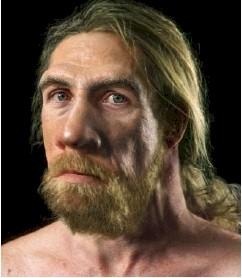




 RSS Feed
RSS Feed
